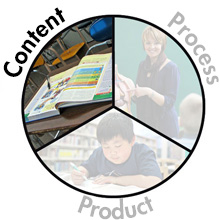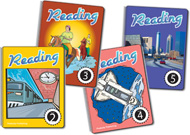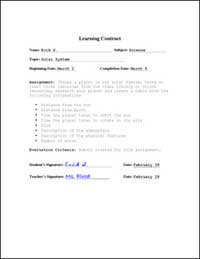How do teachers differentiate instruction?
Page 5: Differentiate Content
 When teachers differentiate content, the same concept or skill is taught to each student; however, the curriculum used to teach the concept or skill might be different for different students. The table below highlights a number of strategies that teachers can use to differentiate content and indicates the student characteristic addressed:
When teachers differentiate content, the same concept or skill is taught to each student; however, the curriculum used to teach the concept or skill might be different for different students. The table below highlights a number of strategies that teachers can use to differentiate content and indicates the student characteristic addressed:
![]() readiness
readiness ![]() interest, and
interest, and ![]() learning profile
learning profile
Click on each link for detailed information about implementing these strategies.
| Strategy | Readiness | Interest | Learning Profile |
| Tiered Content | |||
| Providing a Variety of Materials | |||
| Presentation Styles | |||
| Scaffolding | |||
| Learning Contracts | |||
| Compacting |
Tiered Content
 One way to differentiate content for heterogeneous classrooms is to tier content. When teachers tier content, all students complete the same type of activity (e.g., worksheet, report), but the content varies in difficulty. Typically students are divided into three groups based on readiness levels. The activities assigned to the low, middle, and high groups (groups 1, 2, and 3, respectively) differ in terms of complexity. Below is an example of content that is tiered by readiness.
One way to differentiate content for heterogeneous classrooms is to tier content. When teachers tier content, all students complete the same type of activity (e.g., worksheet, report), but the content varies in difficulty. Typically students are divided into three groups based on readiness levels. The activities assigned to the low, middle, and high groups (groups 1, 2, and 3, respectively) differ in terms of complexity. Below is an example of content that is tiered by readiness.
| Mathematics –Fourth Grade | ||
|
Key Concept: Students develop an understanding of units of time. Lesson: The teacher uses the book The Official M & M’s Book of the Millennium as a means of providing background about time in general and more specifically about the formation of the calendar. |
||
| Group 1 | Group 2 | Group 3 |
| After the teacher reads the first three pages of the book and illustrates the addition of various time units including Roman numerals, the students work in pairs to complete a worksheet which contains some simple problems involving the addition of time units including some which are written in Roman numerals.Next the teacher reads with the students the remainder of the book, which is all about calendars. Students work in pairs to complete a worksheet, which has questions pertaining to the present day Gregorian calendar. | After the students read the first three pages of the book and the teacher illustrates the addition of various time units, the students work in pairs to complete a worksheet which contains more difficult problems involving the addition of time units most of which are written in Roman numerals. Next the students read the remainder of the book, which is all about calendars. Students work in pairs to complete a worksheet, which compares the early Roman calendars with the present day Gregorian calendar. | After the students read the first three pages of the book, the students work in pairs to complete a worksheet of problems of various difficulty levels, which involve the addition of time units all expressed Roman numerals. Next the students read the remainder of the book, which is all about calendars. Students then work in a group to orally compare the various calendars (Chinese, Aztec, & Roman), which are presented in the book. Then the students create a worksheet, which asks questions about the three calendars. |
Adapted from https://www.in.gov/doe/files/Fourth-Readiness-Math.pdf
(Close this panel)
Providing a Variety of Materials
Teachers can differentiate content based on readiness level, interests, or learning profile by offering a variety of materials. This allows students to access the information in the way that works best for them. Teachers might consider offering:
 A range of textbooks: In addition to the grade-level text, the teacher can provide texts one or two grade levels below and above the grade-level text. This allows students who are struggling with the reading level or the complexity of the skill to access the content at the level that is best for them. It also allows students who know the content or quickly master it to have the opportunity to work on more advanced skills.
A range of textbooks: In addition to the grade-level text, the teacher can provide texts one or two grade levels below and above the grade-level text. This allows students who are struggling with the reading level or the complexity of the skill to access the content at the level that is best for them. It also allows students who know the content or quickly master it to have the opportunity to work on more advanced skills.
 Supplemental materials: These materials might include Internet resources, magazines, newspapers, books on CDs, videos, and computer games.
Supplemental materials: These materials might include Internet resources, magazines, newspapers, books on CDs, videos, and computer games.
Teachers might want to build a library of varied textbooks and supplemental materials for differentiating instruction. This library of materials may grow over time as the teacher accumulates used and new books. Alternatively, teachers might locate these resources at the school media center or the public library.
(Close this panel)
Presentation Styles
When they present content, teachers should utilize a variety of presentation styles; that is, they should provide learners with a variety of media and formats that allows students to choose what works best for them. Multiple media and formats also allow students to develop a deeper understanding of concepts by providing opportunities to interact with those concepts in a variety of ways. The table below highlights different methods of presenting content.
 Say It
Say It
Lecture
Discussion
Questioning
Read Aloud
Verbal Description
 Show It
Show It
Pictures/ Graphic
Transparency
White Board
Film
Caption
 Model It
Model It
Demonstrate
Think Aloud
Act Out
Build/ Construct
Use Manipulatives
(Close this panel)
Scaffolding
 For students who struggle with learning a new skill or content, the teacher can provide instructional scaffolding, a process through which a teacher adds supports for students in order to enhance learning and aid in the mastery of tasks. The teacher does this by systematically building on a student’s experiences and knowledge as he or she learns a new skill. As the student increasingly masters the task, the supports are gradually removed. The teacher may need to consider different ways to scaffold for those who have difficulty reading and understanding text and for those who have difficulty mastering a new task.
For students who struggle with learning a new skill or content, the teacher can provide instructional scaffolding, a process through which a teacher adds supports for students in order to enhance learning and aid in the mastery of tasks. The teacher does this by systematically building on a student’s experiences and knowledge as he or she learns a new skill. As the student increasingly masters the task, the supports are gradually removed. The teacher may need to consider different ways to scaffold for those who have difficulty reading and understanding text and for those who have difficulty mastering a new task.
Difficulty Reading and Understanding Text
 The table below suggests a number of ways to scaffold instruction for students who have difficulty reading and comprehending text. The teacher can use the following strategies to help students understand the content. In the beginning, the teacher may be actively involved in helping students implement the strategy. As they learn the strategy, however, the teacher gradually turns over responsibility for implementing the strategy to the students.
The table below suggests a number of ways to scaffold instruction for students who have difficulty reading and comprehending text. The teacher can use the following strategies to help students understand the content. In the beginning, the teacher may be actively involved in helping students implement the strategy. As they learn the strategy, however, the teacher gradually turns over responsibility for implementing the strategy to the students.
| Strategy | Examples of Strategy | |
| Before Reading | Activate prior knowledge |
x
KWL chart glossary |
| Preteach new vocabulary |
|
|
| Make predictions |
|
|
| During Reading | Address unfamiliar words |
|
| Monitor comprehension |
|
|
| Use mental imagery |
|
|
| Use graphic organizers |
|
|
| After Reading | Retell or summarize |
|
Difficulty Mastering a Task
 When a student experiences difficulty learning a new skill or task, the teacher can scaffold the instruction by specifying the task’s steps (i.e., a task analysis) and then modeling those steps while thinking aloud. For example, a teacher scaffolds instruction for a student who is having difficulty adding two two-digit numbers. To begin, the teacher performs a task analysis, breaking the task into manageable steps. Next, the teacher models each step in the task multiple times and allows time for the student to practice. As the student masters the task, the supports are gradually removed.
When a student experiences difficulty learning a new skill or task, the teacher can scaffold the instruction by specifying the task’s steps (i.e., a task analysis) and then modeling those steps while thinking aloud. For example, a teacher scaffolds instruction for a student who is having difficulty adding two two-digit numbers. To begin, the teacher performs a task analysis, breaking the task into manageable steps. Next, the teacher models each step in the task multiple times and allows time for the student to practice. As the student masters the task, the supports are gradually removed.
| Task Analysis (adding two two-digit numbers) |
|
| Step 1: | Add the numbers in the one’s column. |
| Step 2: | If the sum is less than 10, write the number under the one’s column. If the sum is 10 or greater, write the one’s digit under the one’s column and write the ten’s digit on top of the ten’s column. |
| Step 3: | Add the numbers in the ten’s column. If applicable, be sure to include the number you carried. |
| Step 4: | Write the sum of the numbers under the ten’s column. |
To learn more about scaffolding, view the following IRIS Module:
(Close this panel)
Learning Contracts
 A learning contract is an agreement between the teacher and student that specifies in writing the work the student will complete in a given amount of time. A learning contract allows teachers to differentiate the curriculum based on the student’s readiness level or learning profile. When negotiating the contract, the teacher and student need to specify the task to be completed, when it will be completed, the quantity and quality of the work, the criteria by which it will be evaluated, and when appropriate the resulting grade. The contract might also include the consequences for not meeting the terms. Click on the graphics below to view an example of a learning contract or to download a blank learning contract.
A learning contract is an agreement between the teacher and student that specifies in writing the work the student will complete in a given amount of time. A learning contract allows teachers to differentiate the curriculum based on the student’s readiness level or learning profile. When negotiating the contract, the teacher and student need to specify the task to be completed, when it will be completed, the quantity and quality of the work, the criteria by which it will be evaluated, and when appropriate the resulting grade. The contract might also include the consequences for not meeting the terms. Click on the graphics below to view an example of a learning contract or to download a blank learning contract.
Developing effective learning contracts generally requires the skills and proficiency of an experienced teacher. When utilizing learning contracts, the teacher should consider the following:
- Some students might complete their contract early. The teacher should prepare for this and have additional activities related to the content (e.g., computer activities) available for the student.
- Students often require assistance in managing their time. Teachers can provide students with supports, such as daily planning, to help them to stay on schedule.
- Unexpected events (e.g., student is absent, technical glitches) may prohibit the student from completing the contract by the specified due date. In such cases, the teacher might want to offer additional time to complete the contract.
(Close this panel)
Compacting
To differentiate instruction for advanced learners who have already mastered certain content or skills, teachers may want to consider compacting the curriculum. Doing so allows students to skip content they know or to proceed quickly through content. This strategy targets students’ readiness levels and it can be applied to any subject and at any grade level. Compacting the curriculum involves three steps:
 Step 1: Assess student knowledge
Step 1: Assess student knowledge
Prior to the lesson or unit, the teacher assesses the student. Students who score 90% or higher on the pretest might be compacted out of the entire unit, whereas students who score 80–89% (partial mastery) might be compacted out of a portion of it.
 Step 2: Create plan for mastering all parts of the curriculum
Step 2: Create plan for mastering all parts of the curriculum
The teacher creates a plan to make sure the student learns any content not yet mastered.
 Step 3: Create plan for enrichment activities
Step 3: Create plan for enrichment activities
Because students are excused for some or all of the related lessons and assignments for content they have mastered or will learn quickly, the teacher and the student design a plan for how the student will spend his or her free time. To make the student accountable for this work, the teacher may want to present this plan in writing in the form of a compacting agreement (i.e., a specialized learning contract).
Click on the graphics below to view an example of a compacting agreement or to download a blank learning contract specific to compacting.
Research Shows
The National Research Center on the Gifted and Talented (NRC/GT) conducted a study of curriculum compacting. This study included 436 teachers and 783 students in grades 2–6. Researchers found that when 40–50% of the curriculum was eliminated for selected students in a given subject area, no differences were found between the students who received compacting and those who received the full curriculum on the end-of-year achievement test. In other words, the students who experienced a compacted curriculum did not score lower than their peers on these tests.
Reis et. al., (1992).
(Close this panel)
Making adjustments to these instructional elements often requires teachers to change their approach to instruction. Listen as Carol Ann Tomlinson discusses why this is often the biggest challenge teachers encounter when they begin to differentiate instruction (time: 0:46).
Carol Ann Tomlinson, EdD
Professor of Educational Leadership, Foundations, and Policy
The University of Virginia
Charlottesville, VA

Transcript: Carol Ann Tomlinson, EdD
At its core, differentiation is an instructional model, and standards are a curricular issue. So what differentiation really says to teachers is you tell me what you need to teach, and we can show you how to teach it more flexibly and more effectively. So, in essence, differentiation can show you how to differentiate learning the phonebook or how to differentiate learning Shakespeare. So on that level there is no conflict, because differentiation isn’t trying to tell you what you have to teach. It’s just suggesting that frequently teaching in more than one way or with a little more flexibility will help kids learn whatever it is you’re trying to teach more effectively.

